What began as a protest movement by pro-European Ukrainians upset over President Yanukovich’s decision not to sign an Association Agreement with the EU has since turned into one of the biggest crises in Europe since the Yugoslav wars. A year on, Sputnik looks back at historic photos from the epicenter of the crisis – the Kiev Euromaidan protests.
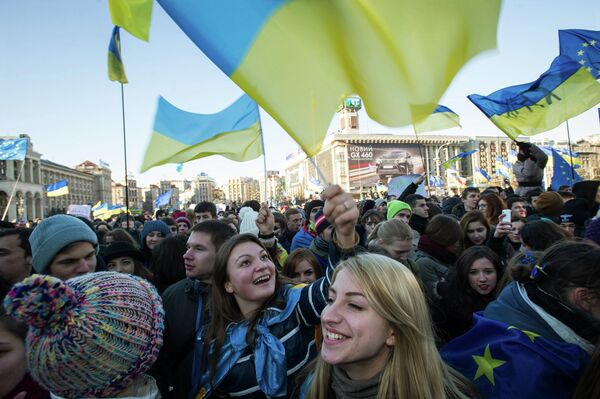
On November 21, 2013, Ukrainska Pravda journalist Mustafa Nayyem posted a Facebook message criticizing the Ukrainian government’s decision earlier in the day not to sign a political and trade Association Agreement with the European Union. “Come on guys, let’s be serious. If you really want to do something, don’t just ‘like’ this post. Write that you are ready, and we can try to start something,” Mustafa wrote. About an hour later he called on his Facebook followers to “meet at 10:30 pm near the monument to independence in the center of Maidan,” and about a thousand people, including opposition journalists and politicians met on the square. On November 29, President Yanukovich officially told EU representatives in Vilnius, Lithuania that Ukraine would not be signing the EU agreement, and the protests grew to 10,000 in Kiev, with another 10,000 estimated to have come out in the western city of Lviv. Protesters shouted pro-EU and anti-Yanukovich slogans, including “Ukraine is Europe!” and “Revolution!”
Above: Kiev university students rallying in favor of integration of the Ukraine into the European Union, November 27, 2013.
Above: Kiev university students rallying in favor of integration of the Ukraine into the European Union, November 27, 2013.

Following a summer of what appeared to be fruitful negotiations on an Association Agreement with the EU, President Yanukovich and Prime Minister Mykola Azarov carried out a sudden about-face, shifting away from the EU and toward Russia in November, 2013. Commentators have speculated that the dire state of the Ukrainian economy, combined with the EU’s modest economic assistance promises and harsh legal demands contributed to the decision. The EU offered the country $838 million in loans, and demanded changes in Ukrainian laws and regulations to move the country’s economy in line with European standards; it was thought that this would cost local industry and agriculture billions of dollars, as local producers would be unable to to compete with European goods. Russia meanwhile offered the Ukraine $15 billion in loans, as well as promises of cheaper gas prices, and did not make any demands for changes in the country’s legal or regulatory environment.
Above: Supporters of Ukraine's integration into the European Union during a rally on Independence Square in Kiev, November 27, 2013.
Above: Supporters of Ukraine's integration into the European Union during a rally on Independence Square in Kiev, November 27, 2013.
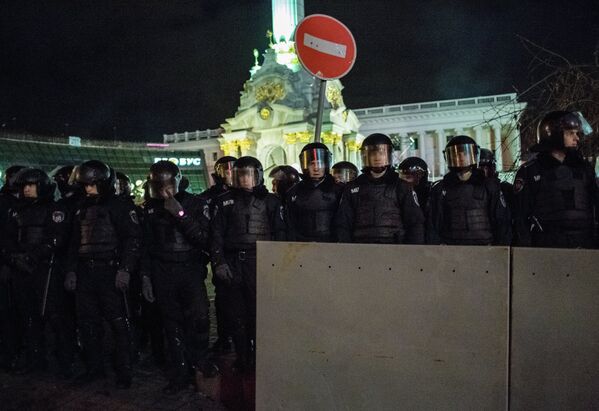
Ukrainians were split on their views of the Association Agreement at the outset of the protests. A study by Ukrainian brand consulting firm Research & Branding Group carried out in early December 2013 found that 46 percent of Ukrainians supported the country’s integration into the EU, while 36 percent supported integration into the Customs Union of Russia, Belarus and Kazakhstan. The study found further that the country was basically divided along geographic lines when it came to which supranational organization people supported, with western and central Ukraine supporting the EU (81 and 56 percent, respectively), while eastern and south Ukraine supported the Customs Union (61 and 54 percent). Support for the Maidan was similarly divided, with 45 percent of those polled supporting the protests, and 49 percent stepping out against them; the figures were again regionally divided.
Above: Berkut riot police forces of the Ukraine's Interior Ministry stand ready to attempt to dismantle a tent camp set up by supporters of European integration on Independence Square in Kiev, November 30, 2013.
Above: Berkut riot police forces of the Ukraine's Interior Ministry stand ready to attempt to dismantle a tent camp set up by supporters of European integration on Independence Square in Kiev, November 30, 2013.
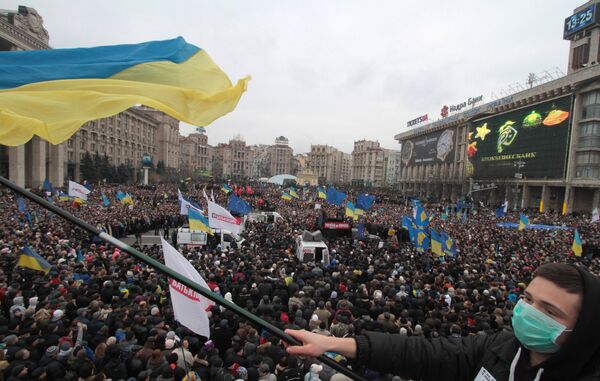
In early December 2013 activists received a boost of public support following the police’s brutal dispersal of the protest camp on the morning of November 30, which left dozens of demonstrators in hospital. President Yanukovich soon sacked Kiev City Manager Oleksandr Popov and the Assistant National Security Chief Volodimir Sikovich over the brutality operation to disperse protesters, but protesters weren’t satisfied. According to a poll by the Ilko Kucheriv Democratic Initiatives Foundation, 70 percent of the protesters coming out to the Maidan in early December had done so to protest police violence on November 30, with 54 percent also citing the government’s failure to sign the Association Agreement.
Above: Supporters of Ukraine's integration with the EU gather on Kiev's Independence Square, December 1, 2013.
Above: Supporters of Ukraine's integration with the EU gather on Kiev's Independence Square, December 1, 2013.
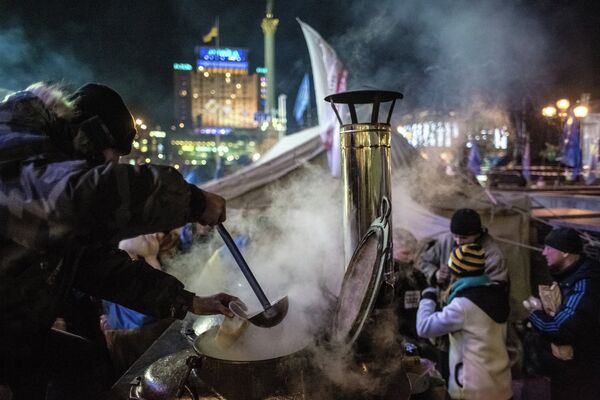
As the protests progressed, the peaceful atmosphere on Maidan gave way to rioting and tire-burning by masked radicals, some of them armed; protesters also began throwing rocks, Molotov cocktails and other projectiles at police.
Above: Hot meals are served for supporters of integration with the EU in a camp on Independence Square in Kiev, December 4, 2013.
Above: Hot meals are served for supporters of integration with the EU in a camp on Independence Square in Kiev, December 4, 2013.
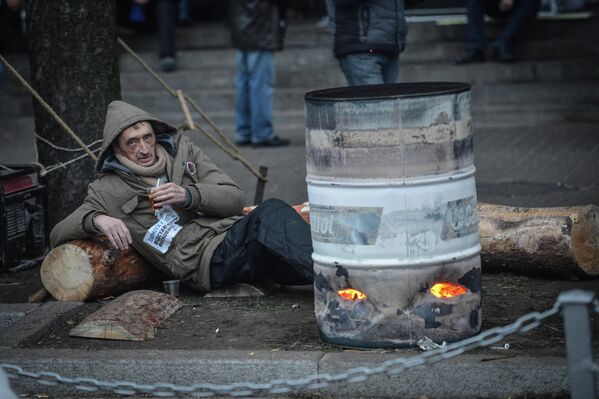
The radicalization of the protest environment saw three people killed in late January 2014, and the conflict reached its apex between February 18-20, 2014, when over 100 protesters and 18 police officers were killed, mostly by sniper fire. While investigations by the new government which overthrew Yanukovich have now concluded that the Ukrainian Ministry of the Interior was responsible for the murders (including those of its own officers), skeptics remain unconvinced, pointing out that it is unlikely that officers would fire on their own comrades, and noting that the killing of protesters by agent provocateurs has been a standard political destabilization tactic used to overthrow inconvenient governments over the course of many decades. In the midst of the confusion, a leaked telephone conversation between Estonian Foreign Minister Urmas Paet and EU Foreign Affairs representative Catherine Ashton revealed that Paet was not certain about who was really behind the killings, noting that “someone from the new coalition,” rather than Yanukovych, may have been responsible. A second leaked conversation between Assistant Secretary of State Victoria Nuland and US Ambassador to Ukraine Geoffrey Pyatt showed what appeared to be an attempt by the United States to play kingmaker in the tumultuous political situation.
Above: A supporter of Ukraine's EU integration warms by the fire on Independence Square, Kiev, December 5, 2013.
Above: A supporter of Ukraine's EU integration warms by the fire on Independence Square, Kiev, December 5, 2013.
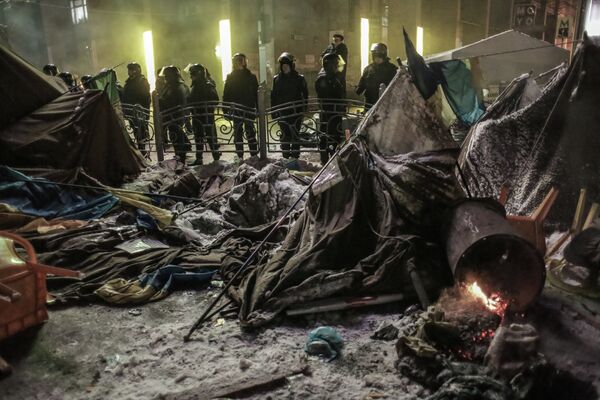
On February 21, Yanukovich and the Maidan opposition leaders signed an EU-brokered peace agreement, but by the next day the Rada voted to remove him from the presidency, in what basically amounted to a coup d’état, since the president’s impeachment was not carried out in accordance with the country’s constitution. Yanukovich fled to Russia on the night of February 21st, panicking after his car was allegedly hit by automatic rifle fire while he was en route to the eastern city of Kharkiv.
Above: Berkut riot police at the charred barricades set up by supporters of Ukraine's integration with the EU on Maidan Square in Ukraine, December 11, 2013.
Above: Berkut riot police at the charred barricades set up by supporters of Ukraine's integration with the EU on Maidan Square in Ukraine, December 11, 2013.
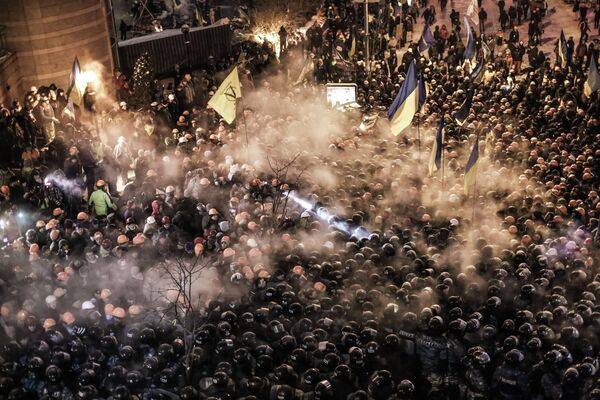
Among the first decisions made by the Rada following Yanukovich’s ouster was a bill to remove the Russian language’s status as the second official language in the country’s eastern regions. The bill was eventually rejected, but not before sparking mass protests in the country’s east and southeast, where Russian language speakers constitute a majority. Adding fuel to the fire were radical Ukrainian nationalist groups’ calls to organize into armed groupings and to travel to the dissenting regions to ‘restore order’ by force. Following ever more radical statements and threats by nationalists in the streets and in government, along with vigilante attacks on opponents of the new regime (some of them even carried out by members of the Rada), local self-defense groups began sprouting up in the east, including the Crimea, as well as Donetsk, Luhansk, Dnepropetrovsk, Kharkiv and Mariupol.
Above: Berkut riot police and supporters of EU integration on the Maidan Square in Kiev, December 11, 2013.
Above: Berkut riot police and supporters of EU integration on the Maidan Square in Kiev, December 11, 2013.
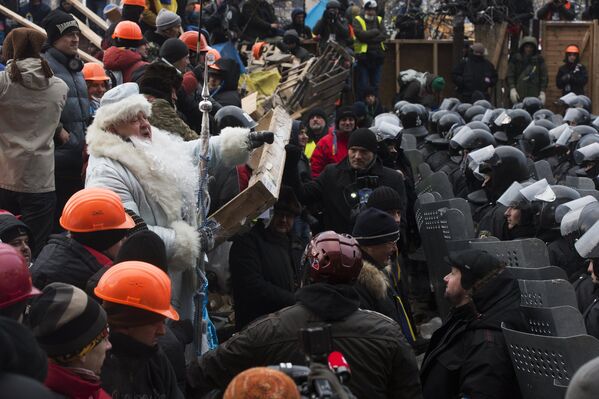
In mid-March, Crimean officials, opposed to the new regime and Kiev and fearing that Ukrainian nationalist bands would cause the same anarchic situation in Crimea that they had in Kiev and elsewhere in the country, organized a referendum to leave Ukraine and to join the Russian Federation. With 83 percent turnout, nearly 97 percent voted to join Russia.
Above: Berkut riot police at the barricades facing supporters of integration with the EU on Maidan Square in Kiev, December 11, 2013.
Above: Berkut riot police at the barricades facing supporters of integration with the EU on Maidan Square in Kiev, December 11, 2013.
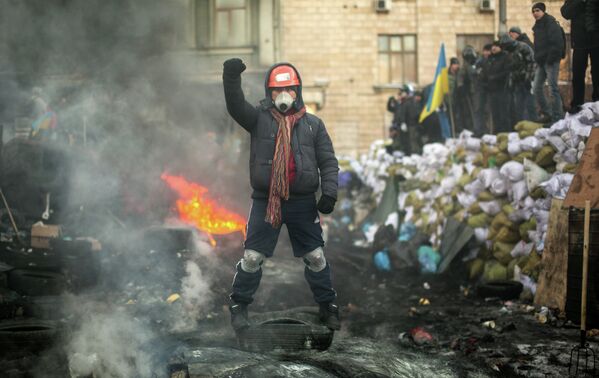
On April 15, fearing ever-growing protests in the country’s east and southeast, Ukraine’s acting President Oleksandr Turchynov and the country’s Maidan-empowered parliament launched what they called an ‘anti-terrorist operation’ in the country’s east, using police and army resources, as well as armed volunteer battalions of radicalized nationalist youth, many of the latter financed by local oligarchs.
Above: A defiant protester on Grushevskogo Street in Kiev, January 24, 2014.
Above: A defiant protester on Grushevskogo Street in Kiev, January 24, 2014.
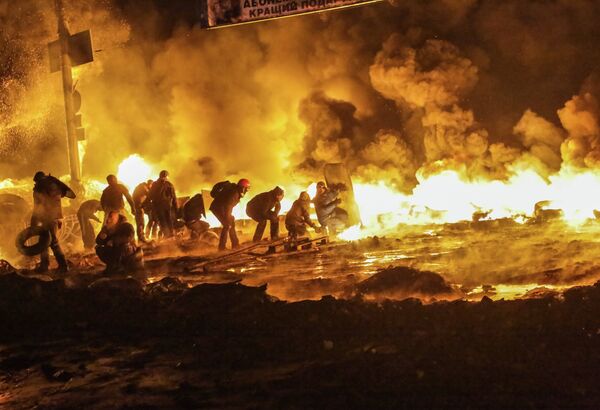
On May 2, dozens of pro-federalization protesters were brutally murdered in the House of Trade Unions building in Odessa, nationalist football hooligans setting fire to the building and blockading protesters inside. The killings, and the Maidan government’s refusal to condemn them, only strengthened fears that similar attacks would become regular fair for opponents of the new regime.
Above: Supporters of European integration of Ukraine clash with police in the center of Kiev, January 25, 2014.
Above: Supporters of European integration of Ukraine clash with police in the center of Kiev, January 25, 2014.
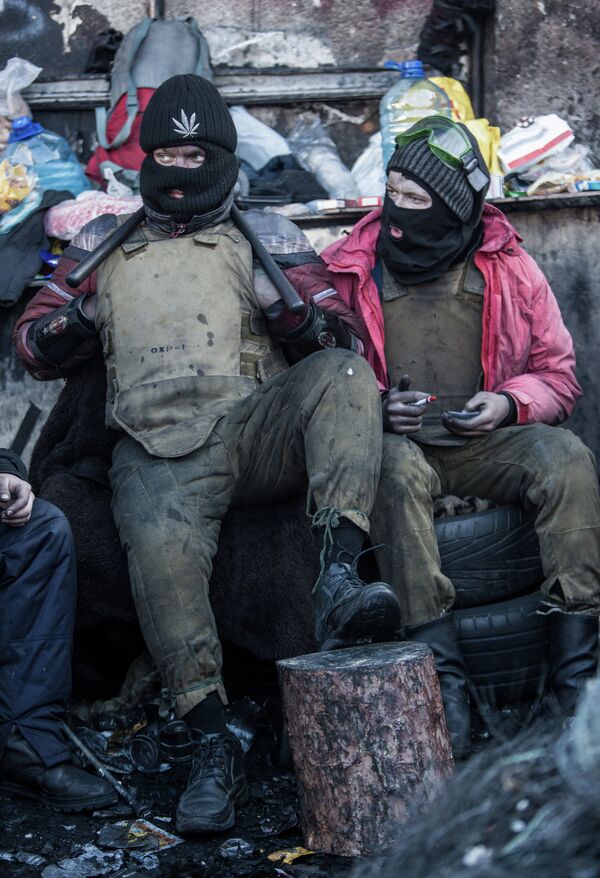
In a snap presidential election held May 25, Ukraine’s ‘chocolate baron’ oligarch and former Yanukovich minister Petro Poroshenko was elected president in elections dominated by turnout from western and central Ukraine. Poroshenko promised to quickly crush resistance in the country’s east by force, including the self-declared Donetsk and Luhansk People’s Republics which had been proclaimed in late April. The military conflict between Kiev and the rebel regions quickly escalated, with at least 2,000 people killed by mid-August according to conservative UN estimates, most of them civilians. The conflict also saw the downing of the Malaysia Airlines Flight 17 over Donetsk, with 298 people on board, which Kiev blamed on the rebels. Unable to crush the ‘people’s militias’ in combat, the Ukrainian army began shelling and bombing rebel-held cities via heavy artillery and airstrikes.
Above: Opposition protesters on Grushevskiy street in Kiev, January 30, 2014.
Above: Opposition protesters on Grushevskiy street in Kiev, January 30, 2014.
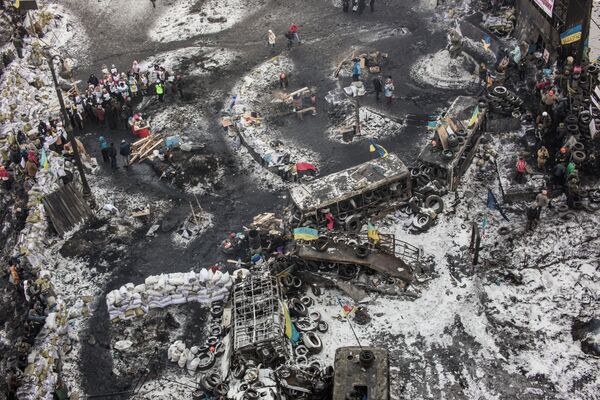
As of November, 2014 the UN estimates that over 4,300 people have been killed and nearly 10,000 seriously injured since the beginning of the conflict in eastern Ukraine, with over a million people internally and externally displaced. Over 2,600 people have also been reported missing to Ukraine’s security services. Since the signing of a truce signed in September, an average of 13 people a day continue to die as the Ukrainian military shells rebel cities, and militia and the Ukrainian military continue fighting.
Above: Opposition supporters and barricades on Grushevskogo Street in Kiev, birds-eye view, January 31, 2014.
Above: Opposition supporters and barricades on Grushevskogo Street in Kiev, birds-eye view, January 31, 2014.
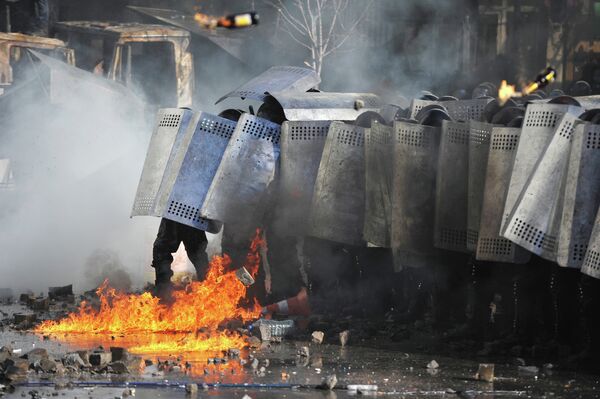
On September 5, representatives of Ukraine, Russia, the DNR and the LPR signed a peace treaty known as the Minsk Protocol, the talks arranged by the Organization for Security and Cooperation in Europe and the Belarusian President Alexander Lukashenko. While the ceasefire has reduced the intensity of the fighting, skeptics have stated that the break in hostilities has merely given the Ukrainian army and the eastern militias breathing room to reorganize and reequip.
Above: Police officers during clashes in the center of Kiev, February 18, 2014.
Above: Police officers during clashes in the center of Kiev, February 18, 2014.
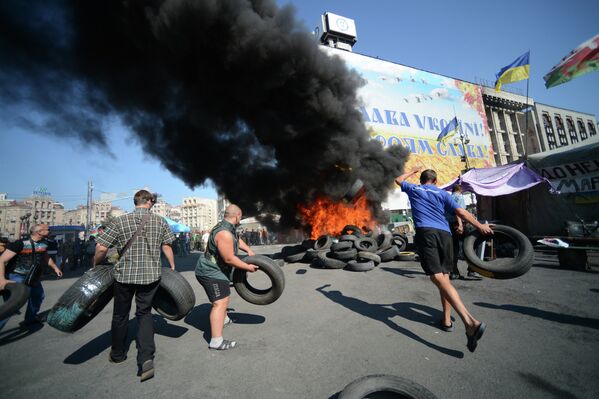
The eastern Ukrainian regions of Donetsk and Luhansk now face a humanitarian crisis, including a lack of access to drinking water, food, medicine and medical care, and heating; Russia has been sending humanitarian convoys to the region since early August, deciding not to wait for the Ukrainian government’s approval after the latter’s attempts to delay the deliveries indefinitely. Ukraine itself also faces an economic crisis and continuing social chaos, including a wave of crime and social instability and a demoralized police force’s inability to effectively respond. The country, on the verge of bankruptcy, also faces cuts to social spending.
Above: Protesters burn car tires on Independence Square (Maidan) in Kiev, summer 2014.
Above: Protesters burn car tires on Independence Square (Maidan) in Kiev, summer 2014.
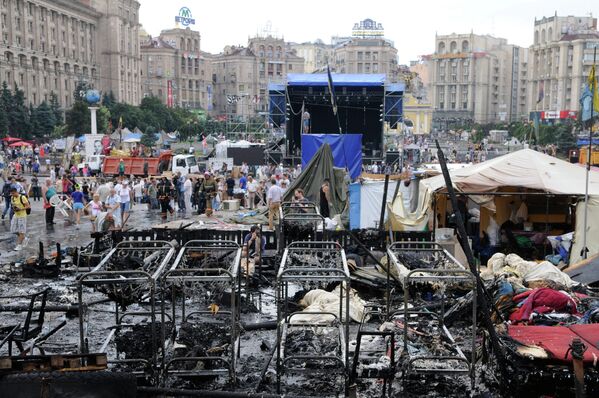
On September 16 Ukraine formally ratified the EU Association Agreement. However, the agreement’s free trade component is being delayed until 2016, on Russia’s insistence, given that a Ukraine-EU free trade regime would force Russia to repeal its preferential treatment regime for Ukrainian goods. The Ukraine-EU agreement, coming at such a high cost, and which many ordinary Ukrainians had hoped would bring economic prosperity and visa-free travel, has so far failed to bring the country any tangible benefits.
Above: Kiev residents and municipal workers clear barricades on Independence Square, August 9, 2014.
Above: Kiev residents and municipal workers clear barricades on Independence Square, August 9, 2014.
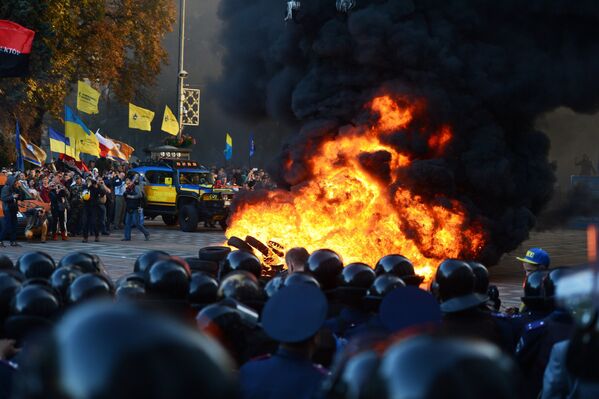
November 21 has been declared a national holiday in Ukraine – the Day of Dignity and Freedom. The country’s leaders attended a wreath-laying ceremony to the ‘Heavenly Hundred’, referring to the protesters killed at Maidan, and Kiev’s City Council has decided to rename a part of Institutskaya Street, where many of the sniper killings took place, the “Heavenly Hundred Heroes Avenue”. US Vice President Biden has joined Ukrainian leaders in Kiev, and the country’s Prime Minister Arseniy Yatsenyuk has signaled hopes that the US visit may bring with it more economic and military assistance from the United States, including lethal weaponry, which President Barack Obama’s administration has so far been hesitant to provide. Visiting US Congress in September, President Poroshenko told lawmakers that while “blankets and night-vision goggles are important…one cannot win a war with blankets.”
Above: Participants in a rally supporting the government's law on lustration for Yanukovich officials set alight near the Verkhovna Rada building in Kiev, September 16, 2014.
Above: Participants in a rally supporting the government's law on lustration for Yanukovich officials set alight near the Verkhovna Rada building in Kiev, September 16, 2014.

